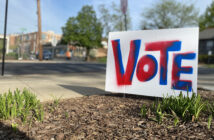English. Math. Active shooter protocol. Science. History.
In recent years, shooting safety drills have worked their way into the daily schedule of school children across the United States.
Columbine. Sandy Hook. Marjory Stoneman Douglas.
Bullets are destroying the futures of students as young as 5 years old, irreparably changing the lives of the student victims, the survivors and their teachers.
Practicing protocols that prepare students and teachers in the event of a shooting, while important reactive measures, undoubtedly instill fear in classrooms. Students shouldn’t have to spend their time worrying about the next massacre. As Parkland survivor Ryan Deitsch said at March For Our Lives on March 24, “the real disruption to the educational process is staring down the barrel of a gun.”
Additionally, teachers now need to add a new lesson to their curriculum: how to protect the classroom in the case of a school shooting. Since when has becoming a teacher become synonymous with defending students from weapons of mass murder?
Today, American schools are forced to teach reactive measures against the threat of gun violence but struggle to enforce proactive measures.
Schools should not be left to deal with these issues on their own. Legislators need to be willing to enact change.
While there are many discussions surrounding the factors that result in a mass shooting, including terrorism and lackadaisical gun laws, another factor to consider is mental health.
Mental health does not excuse mass shootings — most people who struggle with mental health problems do not violently act out to such extremes.
However, there may be a link between poor mental health and societal pressures placed upon men and boys to act and feel a certain way.
When children are young, they are allowed to freely experience their emotions, regardless of gender. However, as they grow into adolescents, it often seems as though young men are not permitted to express a full range emotions, leaving them to channel “unacceptable” feelings like fear and sadness into the one emotion society permits them — anger.
The aggressors of the most recent school shootings have been young men.
This, along with the lack of mental health education and discussion in schools may explain their violent tendencies, but it does not excuse them.
For young boys who are growing into this societal expectation of masculinity, there is certainly internal conflict — especially if they lack an outlet or source of trust.
While schools around the country are unable to create legislation to prevent gun violence, they can be proactive by improving mental health education and increasing resources for students.
This is certainly not the only answer, but mental health education could reduce the number of young people who feel like there is nowhere left to turn but toward gun violence.
There is no simple solution to the epidemic of gun violence in our country. Gun reform legislation, destigmatizing mental health and gun violence awareness will not end mass shootings if enacted individually. But when enacted together, these factors could culminate in a movement in a positive direction.
We can’t just teach our children how to protect themselves from a shooter in the classroom. We need to stop the possibility of school shootings altogether.





Comment policy
Comments posted to The Brown and White website are reviewed by a moderator before being approved. Incendiary speech or harassing language, including comments targeted at individuals, may be deemed unacceptable and not published. Spam and other soliciting will also be declined.
The Brown and White also reserves the right to not publish entirely anonymous comments.
1 Comment
Teach respect for others; it solves a host of problems. Respected people tend not to be angry. Teach mothers and fathers to be parents not selfish adults.